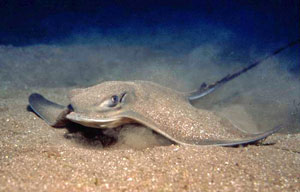Common eagle ray facts for kids
Quick facts for kids Common eagle ray |
|
|---|---|
 |
|
| Conservation status | |
| Scientific classification | |
| Synonyms | |
|
The common eagle ray (also called the bullray) is a type of fish that belongs to the eagle ray family. Its scientific name is Myliobatis aquila. You can find this ray in the eastern Atlantic Ocean, from the North Sea all the way to South Africa. It also lives in the Mediterranean Sea and the southwestern Indian Ocean.
Contents
What Does It Look Like?
The common eagle ray can grow quite large. It can reach up to about 6 feet (183 cm) long. Its body, called a disc, can be up to 2.6 feet (80 cm) wide. However, most of these rays are smaller than that. Female rays usually grow bigger than males.
This ray is brown or black on its back. Its belly is white. It has a diamond-shaped body. Two big, triangular fins stick out from its sides, like wings. It also has one fin on its back. Its snout (nose area) is blunt and rounded. The tail is long and thin. It has a large spine near its body, but no tail fin. This spine can inject venom, but it's not usually dangerous to humans.
Where Does It Live?
This ray lives in the eastern Atlantic Ocean. This includes areas from the British Isles down to South Africa. It also extends into the Indian Ocean. You can also find it in the Mediterranean Sea.
Common eagle rays live both close to the shore and further out in the open ocean. They can be found at depths of up to 2,600 feet (800 meters). However, they spend most of their time in shallower water, less than 160 feet (50 meters) deep. They often prefer open, sandy areas on the seabed. They have also been seen in lagoons, especially during certain times of the year.
How Does It Live?
What Does It Eat?
The common eagle ray mostly eats small creatures that live on the seabed. These include crustaceans like crabs and shrimp. They also love to eat clams and other shelled animals. They dig these foods out of the sand.
Sometimes, they also eat worms, snails, and small fish. Bigger rays tend to eat more fish than smaller ones. Instead of pointy teeth, these rays have flat, hexagonal plates in their jaws. These plates work like a mosaic. They use them to crush the hard shells of their prey.
How Does It Reproduce?
Common eagle rays sometimes gather in large groups when it's time to reproduce. They are ovoviviparous. This means the mother carries her eggs inside her body. The young rays hatch from their eggs while still inside the mother. They get food from their egg yolks at first. Later, they get special fluids from their mother.
The mother carries her babies for about 6 to 8 months. After this, she gives birth to live young. A female ray usually has between three and seven pups at a time. Young rays have been seen in different places at different times of the year, like off the coast of France between May and September.
Parasites
Like many animals, common eagle rays can have tiny creatures called parasites living on or inside them. These parasites don't usually harm the ray too much. For example, some parasites live on their skin, while others live in their gills.
Rays and Humans
Is It Dangerous?
The common eagle ray has a spine that can inject venom. However, it is not considered dangerous to humans. If someone is stung, the effects are usually not very strong.
Fishing
These rays are sometimes caught by accident by fishing boats. This is called "bycatch." In the past, many more were caught. Now, fewer are caught because their numbers have gone down.
In some areas, like the Adriatic Sea, fishing boats might catch one common eagle ray for every 20 times they cast their nets. About 79% of these rays are released alive after being caught. They are more often caught in shallower, northern areas between April and September.
Tourism
Common eagle rays are important for tourism. SCUBA divers and underwater photographers love to see them. They are a beautiful sight in the ocean!
What's in Their Bodies?
Scientists have studied what builds up in the bodies of these rays. For example, they looked at mercury levels. Common eagle rays usually have lower levels of mercury than some other fish. This is probably because they eat invertebrates, which are lower on the food chain. However, they might have higher levels of arsenic in their bodies compared to other types of rays that swim in open water.
Status in the Wild
The International Union for Conservation of Nature (IUCN) has listed the common eagle ray as "critically endangered". This means their numbers are very low, and they are at a high risk of disappearing forever.
The exact number of these fish is hard to know. Some scientists think that the rays in the Mediterranean Sea might even be a different species from those in the Atlantic. In the Mediterranean, their numbers dropped a lot in the 1970s. They are still threatened by lots of fishing there. Their population has also gone down in the Atlantic Ocean near Europe. They used to be very common there, but now they are rare.
Along the coast of West Africa, people also fish for them. However, this fishing is not as intense. Because of this, the ray populations there might be more stable.


